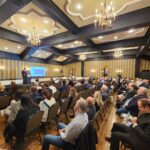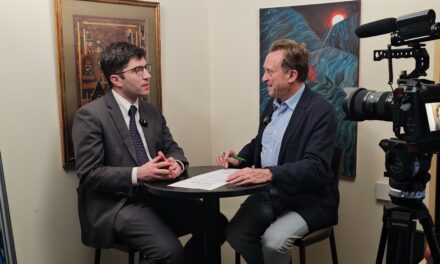Nick Sakaliuk as an internee inside Fort Henry, circa 1915 (he is the second man seated from the left in the first row of four)
Lubomyr Luciuk
The ghost shimmers into view, a spectre haunting a casemate deep within Fort Henry’s interior. He has returned to a familiar place, more than 100 years after first setting foot here.
We know the precise date of his original appearance. It was a Saturday, 17 October 1914, a cool autumn day in Kingston. Fort Henry would be the first, but not the only, internment camp he was confined in while still mortal – in the summer of 1916 he was transported to Petawawa and, in 1917, moved even deeper into Ontario’s frontier hinterland, up to Kapuskasing. If you and I had been alive back then we might have caught a glimpse of him doing hard labour for the profit of his jailers. Eventually, like others rounded up during Canada’s first national internment operations (at least those not deported), he was paroled to return to civilian life. This conditional release came in November 1918, just after the Great War ended. Overall, he spent 39 months behind Canadian barbed wire
His name was Nykola Sakaliuk. His fellow inmates and their guards called him Nick. It was easier to pronounce. He told them he was a Ukrainian but his keepers didn’t care. They branded him an “Austrian” because he had immigrated from Bukovyna, a region of western Ukraine then within the Austro-Hungarian Empire. Innocent of any wrongdoing, his arrest was provoked by prewar prejudices and wartime xenophobia. He was no threat at all to national security.
Nick was not the first Ukrainian to arrive in our town. Other “Austrians” had settled before the First World War, most finding work in the Davis Tannery. None of them were arrested. Nick wasn’t as lucky. Captured in Montreal, he was brought to this city’s citadel under guard. After they sent him to northern Ontario he never wanted to return here.
I met Nick on 14 February 1978. Only a few days earlier I got a copy of Sir William Desmond Otter’s report on the internment operations of 1914-1920. I already knew Japanese Canadians were mistreated in the Second World War. But no one ever spoke of Ukrainians as victims of the War Measures Act, despite the fine education I got from the Jesuits at Regiopolis-Notre Dame and, later, good professors at Queen’s University.
When I began graduate studies I also started a diary. I still write in it. After first meeting Nick I recorded:
“…travelled a long way out to see Mr Sakaliuk, never realizing what a lucky find I was about to make. For here was an elderly gentleman who, despite being hard of hearing, nevertheless had a crystal-clear remembrance of his long years in Canada. Further he was also an inmate of the internment camps… He even had a group photograph of Ukrainian prisoners in his Cell #19 at Fort Henry! We spent nearly 3 hours talking and I questioned him as thoroughly as possible about those days in Canada…”
In my MA on the historical geography of Ukrainians in Kingston I referenced the internment operations. I even visited Nick and his wife, Kalyna, in November 1980, writing that “…his handshake was still firm…his manner still sure,” adding: “Our world needs more people of the tough stock from which they spring.”
I never saw Nick again. He was accidentally killed on Valentine’s Day 1981 – exactly three years to the day on which we first spoke.
So how did Sakaliuk’s spirit return to this city in this century? That story begins in a refugee camp near Vienna, in 1982. Representing the Ukrainian Refugee Aid Committee, I was helping people fleeing Poland after the collapse of the Solidarity movement. One of them was Yosyp Terlicki. Along with several other asylum-seekers, we resettled him in Kingston. Although they all moved on to find jobs, I’d occasionally hear of Yosyp and knew he was active in Zahrava, a community-based theatre in Toronto.
Meanwhile, supporting the commemorative and educational mandate of the Canadian First World War Internment Recognition Fund, I had spent many years advocating for a permanent exhibit at Fort Henry, Nick’s testimony having motivated me to spearhead the Ukrainian Canadian community’s redress campaign. Even so, when it came to designing this particular display, now open to the public, I played but a secondary role.
So imagine my surprise when the actor selected to portray Nykola was none other than Yosyp. The serendipity of having someone I got to Canada giving voice to another immigrant who taught me something about this country I would otherwise never have known, is a blessing. And so, decades after giving witness to what he endured as an “enemy alien,” Nick’s words can be heard again, as his ghost-like figure reappears inside the Fort, orchestrated through the illusion of a Pepper’s Ghost hologram. Not exactly the man himself, of course, but a shade of Nykola, brought back to where he was once held captive. While still not among us by choice, he is now here to teach, not toil. This time I know he doesn’t mind.
Share on Social Media



































